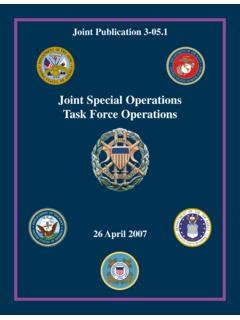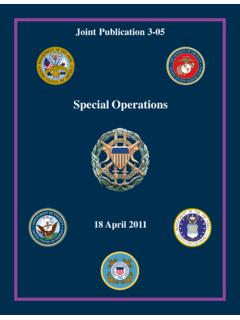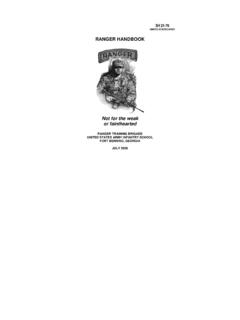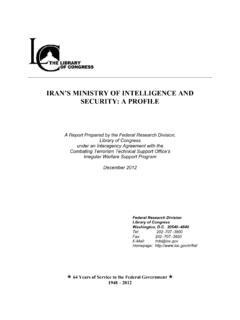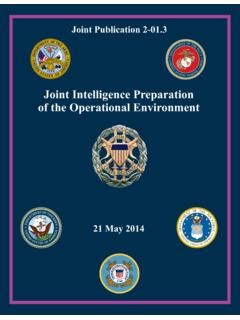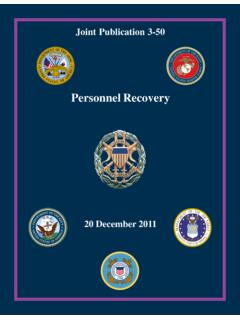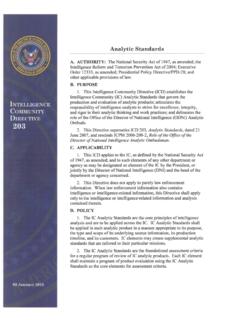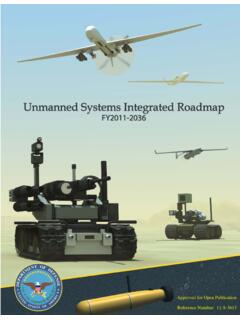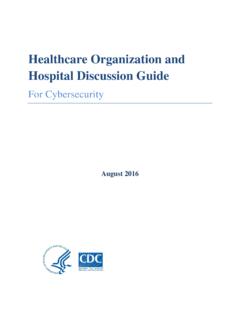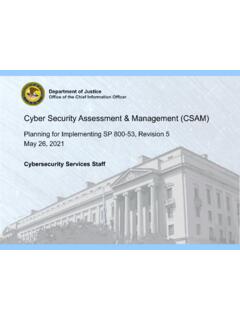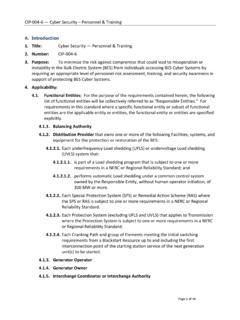Transcription of JP 3-12 (R), Cyberspace Operations
1 DEPAOTMENTFTHEARMY EUNITEDSTATSOAFAMERICRTHISWE'LLDEFENDJ oint Publication 3-12 (R) Cyberspace Operations5 February 2013i PREFACE 1. Scope This publication provides joint doctrine for the planning , preparation, execution, and assessment of joint Cyberspace Operations across the range of military Operations . 2. Purpose This publication has been prepared under the direction of the Chairman of the Joint Chiefs of Staff. It sets forth joint doctrine to govern the activities and performance of the Armed Forces of the United States in joint Operations , and provides considerations for military interaction with governmental and nongovernmental agencies, multinational forces, and other interorganizational partners.
2 It provides military guidance for the exercise of authority by combatant commanders and other joint force commanders (JFCs), and prescribes joint doctrine for Operations and training. It provides military guidance for use by the Armed Forces in preparing and executing their plans and orders. It is not the intent of this publication to restrict the authority of the JFC from organizing the force and executing the mission in a manner the JFC deems most appropriate to ensure unity of effort in the accomplishment of objectives.
3 3. Application a. Joint doctrine established in this publication applies to the Joint Staff, commanders of combatant commands, subordinate unified commands, joint task forces, subordinate components of these commands, and the Services. b. The guidance in this publication is authoritative; as such, this doctrine will be followed except when, in the judgment of the commander, exceptional circumstances dictate otherwise. If conflicts arise between the contents of this publication and the contents of Service publications, this publication will take precedence unless the Chairman of the Joint Chiefs of Staff, normally in coordination with the other members of the Joint Chiefs of Staff, has provided more current and specific guidance.
4 Commanders of forces operating as part of a multinational (alliance or coalition) military command should follow multinational doctrine and procedures ratified by the US. For doctrine and procedures not ratified by the US, commanders should evaluate and follow the multinational command s doctrine and procedures, where applicable and consistent with US law, regulations, and doctrine. For the Chairman of the Joint Chiefs of Staff: CURTIS M. SCAPARROTTI Lieutenant General, Army Director, Joint Staff Preface ii JP 3-12 Intentionally Blank iii TABLE OF CONTENTS PAGE EXECUTIVE SUMMARY.
5 V CHAPTER I INTRODUCTION Introduction .. I-1 Cyberspace .. I-2 Integrating Cyberspace Operations .. I-6 The Joint Force and Cyberspace .. I-6 CHAPTER II Cyberspace Operations Introduction .. II-1 Military Operations In and Through Cyberspace .. II-2 National Intelligence Operations In and Through Cyberspace .. II-5 Department of Defense Ordinary Business Operations In and Through Cyberspace .. II-6 The Joint Functions and Cyberspace Operations .. II-6 CHAPTER III AUTHORITIES, ROLES, AND RESPONSIBILITIES Introduction.
6 III-1 Authorities .. III-2 Roles and Responsibilities .. III-2 Legal Considerations .. III-10 CHAPTER IV planning AND COORDINATION Joint Operation planning Process and Cyberspace Operations .. IV-1 Cyberspace Operations planning Considerations .. IV-1 Command and Control of Cyberspace Operations .. IV-6 Synchronization of Cyberspace Operations .. IV-9 Assessment of Cyberspace Operations .. IV-10 Interorganizational Considerations .. IV-12 Multinational Considerations .. IV-13 APPENDIX A References.
7 A-1 B Administrative Instructions .. B-1 Table of Contents iv JP 3-12 GLOSSARY Part I Abbreviations and Acronyms .. GL-1 Part II Terms and Definitions.
8 GL-4 FIGURE I-1 The Three Layers of Cyberspace .. I-3 III-1 United States Code-Based Authorities .. III-3 IV-1 Cyberspace Command and Control Organizational Construct .. IV-8 v EXECUTIVE SUMMARY COMMANDER S OVERVIEW Introduces Cyberspace and its integration into joint Operations . Explains Cyberspace Operations and their relationship to joint functions. Covers authorities, roles, and responsibilities. Discusses planning and coordination of Cyberspace Operations . Introduction Cyberspace Operations (CO) are the employment of Cyberspace capabilities where the primary purpose is to achieve objectives in or through Cyberspace .
9 Most aspects of joint Operations rely in part on Cyberspace , the global domain within the information environment consisting of the interdependent network of information technology infrastructures and resident data, including the Internet, telecommunications networks, computer systems, and embedded processors and controllers. Developments in Cyberspace provide the means for the US military, its allies, and partner nations to gain and maintain a strategic, continuing advantage in the operational environment (OE), and can be leveraged to ensure the nation s economic and physical security.
10 Access to the Internet provides adversaries the capability to compromise the integrity of US critical infrastructures in direct and indirect ways. These characteristics and conditions present a paradox within Cyberspace : the prosperity and security of our nation have been significantly enhanced by our use of Cyberspace , yet these same developments have led to increased vulnerabilities and a critical dependence on Cyberspace , for the US in general and the joint force in particular.
